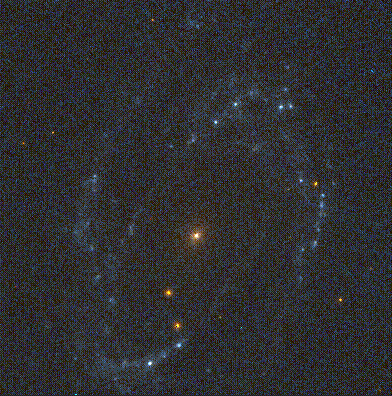 This color image is a composite of photographs over the 1500-2500 Angstrom
range, deep in the ultraviolet; for the comparison, visible light comprises
roughly the 4000-7000 Angstrom range. The most prominent objects are clusters
and associations of young stars, dominated by the light of their brightest and
hottest members - in general, going to shorter wavelengths stresses hotter
objects.
The central bulge of M81 has almost vanished, and we now see the ultraviolet
light of the weakly active nucleus of M81 at the very core. Close comparison
will show that most of the UV sources in the spiral arms can be identified
with blue knots in visible light and H-alpha sources, but that there are
large differences in the ultraviolet properties of clusters that appear quite
similar in visible light.
These differences are a combination of differing ages and effects of dust.
While dust in and around a young cluster absorbs blue light more effectively
than red, its power is greater yet in the ultraviolet, so we will have a clear
view of only the least shrouded clusters.
This color image is a composite of photographs over the 1500-2500 Angstrom
range, deep in the ultraviolet; for the comparison, visible light comprises
roughly the 4000-7000 Angstrom range. The most prominent objects are clusters
and associations of young stars, dominated by the light of their brightest and
hottest members - in general, going to shorter wavelengths stresses hotter
objects.
The central bulge of M81 has almost vanished, and we now see the ultraviolet
light of the weakly active nucleus of M81 at the very core. Close comparison
will show that most of the UV sources in the spiral arms can be identified
with blue knots in visible light and H-alpha sources, but that there are
large differences in the ultraviolet properties of clusters that appear quite
similar in visible light.
These differences are a combination of differing ages and effects of dust.
While dust in and around a young cluster absorbs blue light more effectively
than red, its power is greater yet in the ultraviolet, so we will have a clear
view of only the least shrouded clusters.
This image began as a photograph in the exact sense, after which each component image was scanned with a microphotometer and subsequently calibrated and processed digitally. The data were taken by the Ultraviolet Imaging Telescope (UIT), part of the Astro-1 payload carried aboard the space shuttle Columbia in December 1990. They were provided courtesy of the UIT Team, T. Stecher, Principal Investigator. In this realization, the colors are real in the sense that objects appearing redder produce more light at the longer-wavelength end of the ultraviolet window. Some slight scratches from the film-transport mechanism appear in the blue (deeper-ultraviolet) part of this composite.
Last changes: 5/2001 © 2001